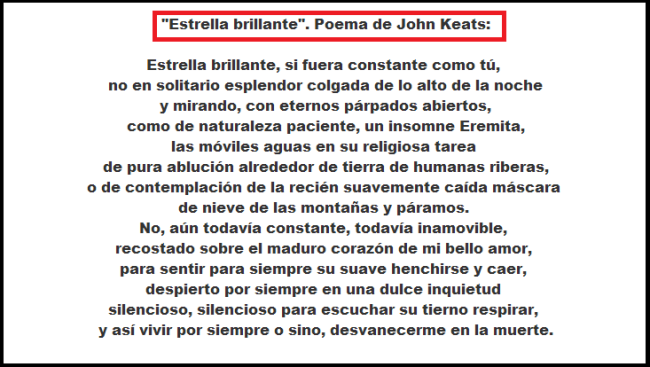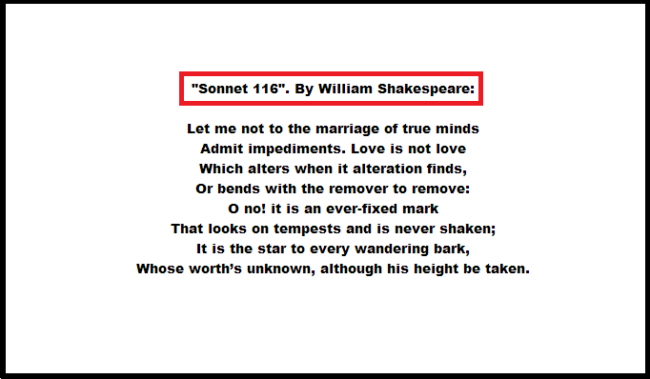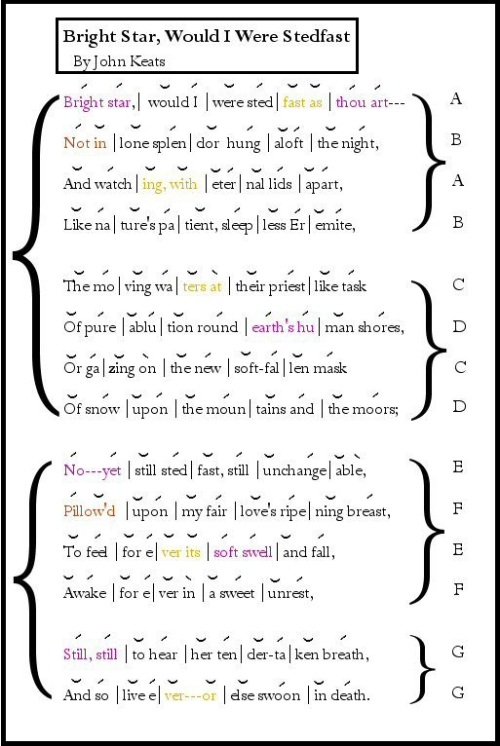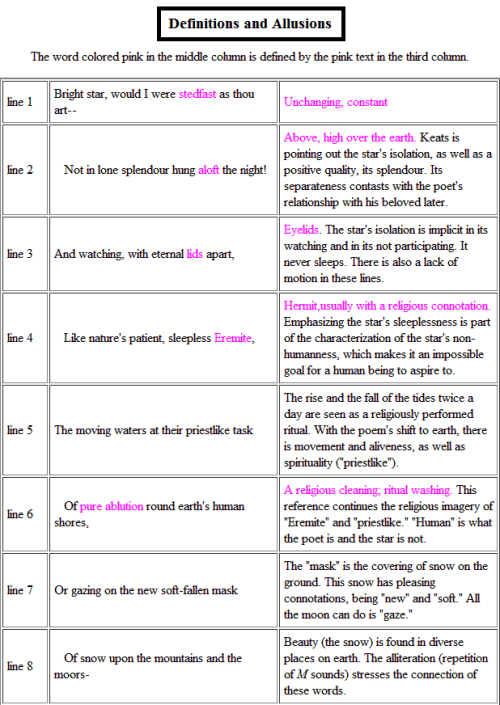♠Poetry / Poesia: John Keats:
“Bright Star” (Sonnet) / “Estrella Brillante” (Soneto):
________________________________________________________________________________________________________
♠Poesía: John Keats: “Estrella Brillante”: Reseña:
“Si firme y constante fuera yo, brillante estrella, como tú”… es el inicio del último poema que escribió John Keats el 28 de septiembre de 1820, mientras se alejaba de la isla de Wight, rumbo a Nápoles. El viaje a Italia era la última oportunidad de conquistar lo imposible, que en su caso, era buscar una posibilidad de sanar de la tuberculosis que persiguió como una epidemia a varios miembros de su familia.
El poema “Estrella Brillante “fue uno de sus últimos poemas, dedicándoselo a su amada Fanny Brawne. Exceptuando los que escribió por pura desesperación en el puerto de Nápoles durante la cuarentena que le obligó a estar encerrado en el navío María Crowther durante una semana.
“Estrella Brillante ” es uno de los poemas románticos de Keats, que tanto su amigo Charles Brown en Inglaterra como su fiel y último compañero Joseph Severn en Italia, coincidieron en definirlos como la melancolía de lo inalcanzable.
John Keats murió en los brazos de su amigo Joseph Severn el 23 de febrero de 1821, en el 26 de la Plaza de España, en la ciudad de Roma. Está enterrado en el Cementerio Protestante de aquella ciudad. Junto a él está enterrado Joseph Severn y también las cenizas del poeta Shelley.
Según lo reglamentado por las autoridades italianas, todos los muebles de Keats fueron quemados, menos un piano, porque era alquilado. Los suelos, ventanas y paredes del cuarto fueron destruidos y mandados a hacer de nuevo. Los empapelados de las paredes fueron removidos y renovados. Se hacía así siempre con las víctimas de tuberculosis.
Fanny Brawne se enteró de la muerte de John Keats un mes después. Pasó en duelo seis años. El poema “Estrella brillante” se publicó por primera vez en 1838, diecisiete años después de la muerte de Keats.
En su lápida está labrada una lira de ocho cuerdas, cuatro de ellas rotas. Y las palabras que pidió fueran grabadas sobre su tumba: “Aquí yace aquel cuyo nombre fue escrito en el agua” (“Here Lies One whose name was writ in water”).
____________________________________________________________________________________________________________
_________________________________________________________________________________________________________________
►ENGLISH SECTION ►
♠Poetry: John Keats: “Bright Star” (Sonnet):
___________________________________________________________________________________________________________________
♠Audio Video: Sonnet By John Keats:
“Bright Star” (“Bright Star, Would I were Stedfast as thou Art”)
__________________________________________________________________________________________________________________
♠”Analysis of John Keats´s Sonnet Bright Star”:
Colleen Walles highlights on her thorough article on Romanticism at HSC Online that:
“The bright star in the sonnet can be a metaphorical conceit for the appeal and danger of fickle, female sexuality as in “La Belle Dame Sans Merci”. Keats identifies with the evening star and the symbolism is organic in the octave even when he rejects isolation and identification with nature. He implicitly contrasts the sublime and eternal beauty of nature to human life and individual freedom. The sestet privileges concrete over abstract but undermine notions of permanence by paradoxical passivity and a downward movement to acceptance of loss and death”.
As Patrick Gillespie craftily highlights on his post “Bright Star by John Keats, His Sonnet” at PoemShape.wordpress.com
“Bright Star is one of Keats’s earlier poems and I can’t help but detect the opening of Shakespeare´s Sonnet 116
Shakespeare equates love to a star and this association was surely present in Keats’ s mind from the time he first read Shakespeare’s Sonnet. That is, the star isn’t only a symbol of steadfastness and stability, but also love. And love, in Keats’s mind, is unchangeable and ever-fixèd (or else it isn’t love)”.
_________________________________________________________________________________________________________________
_________________________________________________________________________________________________________________
___________________________________________________________________________________________________________________
♠”Bright Star” By John Keats: Sonnet Structure:
(Credit: Patrick Gillespie, “Bright Star by John Keats, His Sonnet” at PoemShape.wordpress.com)
___________________________________________________________________________________________________________________
♠Structure of John Keats´s Sonnet “Bright Star”:
In many of Keats’s poems, the speaker leaves the real world to explore a transcendent, mythical, or aesthetic realm. At the end of the poem, the speaker returns to his ordinary life transformed in some way and armed with a new understanding. Often the appearance or contemplation of a beautiful object makes the departure possible. The ability to get lost in a reverie, to depart conscious life for imaginative life without wondering about plausibility or rationality, is part of Keats’s concept of negative capability. In “Bright star, would I were stedfast as thou art,” the speaker imagines a state of “sweet unrest” in which he will remain half-conscious on his lover’s breast forever. As speakers depart this world for an imaginative world, they have experiences and insights that they can then impart into poetry once they’ve returned to conscious life.
The final rhyming couplet speaks of life and death. He wishes to ‘live ever’ listening to her ‘tender-taken breath’, ‘or else swoon in death’. Here once again we can observe the interaction between the moment and eternity – if he continues to love her he will live eternally, stedfast like the star. If he ceases to hear her breath – ceases to love – he will die. Interestingly, this last line could almost be the volta in the poem – as the love seems to for the first time to question whether the moment, love, will last forever, and what the alternative would be.
As Lilia Melani points out in her analysis of Keats ´s sonnet at academicbrooklyn.cuny.edu:
“Once the poet eliminates the non-human qualities of the star, he is left with just the quality of steadfastness. He can now define steadfastness in terms of human life on earth, in the world of love and movement. As in so many poems, Keats is grappling with the paradox of the desire for permanence and a world of timelessness and eternity (the star) while living in a world of time and flux. The paradox is resolved by the end of the poem: joy and fulfillment are to be found here, now; he needs no more. There is a possible ambiguity in the last line; is Keats saying that even if love doesn’t enable him to live forever, he will die content in ecstasy and love?”
__________________________________________________________________________________________________________________
♠John Keats´s Sonnet “Bright Star”: Allusions & Meanings (Modern English):
(Credit: Lilia Melani: Analysis of “Bright Star”)
________________________________________________________________________________________________________________
♠Original Manuscript of Keats´s Sonnet “Bright Star” (1819):

This famous sonnet was written by Keats in his copy of ‘The Poetical Works of William Shakespeare’ (1819).-
________________________________________________________________________________________________________________
♠Links Post:
http://anywayidontcare.blogspot.com.ar/2011/12/poemas-de-john-keats.html?spref=tw
http://canal-literatura.com/blog/sin-categoria/homenaje-a-john-keats-el-poeta-de-la-melancolia-inalcanzable/
http://www.sparknotes.com/poetry/keats/themes.html
http://www.press.uchicago.edu/Misc/Chicago/542409.html
http://poemshape.wordpress.com/2009/05/10/bright-star-by-john-keats-his-sonnet/
http://academic.brooklyn.cuny.edu/english/melani/cs6/star.html
http://www.youtube.com/watch?v=Fg2QoGJ4-h0 (Trailer”Bright Star”)
https://aquileana.wordpress.com/2013/09/21/poesia-john-keats-al-otono-poetry-john-keats-to-autumn/ (“To Autumn”, Poem By John Keats)
https://aquileana.wordpress.com/2009/04/25/john-keats-la-belle-dame-sans-merci/ (“La Belle Dame Sans Merci”. Poem By John Keats).
❖Worth Reading❖ A Sonnet by Irina Dimitric:
“My Sweet Rose” at Irina´s Poetry Corner
►MY SWEET ROSE►
How sweet and pure thy perfume grows,
As sweet as seasoned showers to the ground
Upon which thy gracious beauty glows,
I swear my love for ever to thee bound.
Ah, my sweetest rose! I long and pine
For cosy softness of thy velvet shine.
Come, do not tarry! Make haste ere Time’s quick pace
Hath ploughed the furrow through my flesh and bones.
Why did thou forsake me? Thou needed space?
For thou did love me, that too, the Almighty knows.
But when I sleep, our two hearts meet in dreams,
My groaning melancholy gone in thy embrace.
All days as nights do seem to me
Until the day my eyes see thee.
© irina dimitric 2013
இڿڰۣ-ڰۣ—
________________________________________________________________________________________________________________________________
The first version of this poem was written in 2011 for Wednesday Writing Essential prompt at gather.com:
‘Write a response without any verbs of being and at least one allusion to Shakespeare.’ We were allowed to borrow a line from Shakespeare. Line Two in this poem is borrowed from one of his sonnets; I might still, one day, find which one! Or, perhaps you could find it for me. However, I did find the sonnet which provided the idea for my final couplet: it is Sonnet 43
I started revising the poem three days ago, polishing the metre and rhyme. It was Aquileana’s brilliant post on John Keats https://aquileana.wordpress.com/ that renewed my interest in the sonnet. When I looked up Sonnet on Google, I realised my original version was only a sonnet-like poem: it consisted of three quatrains and a couplet, but the rhyme in the second half of the second quatrain had to be altered and consequently adjusted in the third quatrain; and I paid more attention to metre. Although the language is archaic in some lines, I can call it a Modern Sonnet owing to its peculiar rhyming scheme: a b a b c c d a d a a d e e.
This is my very first and only sonnet. I hope you like it. ~ Have a nice weekend! ~ Irina 🙂









